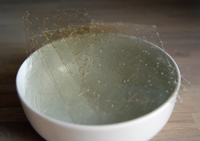
Photo from wikipedia
Hydrogels are composed of a crosslinked polymer network and water. The constitutive behaviors of hydrogels have been modeled based on Flory-Huggins theory. Within this model, the thermodynamic and kinetic parameters… Click to show full abstract
Hydrogels are composed of a crosslinked polymer network and water. The constitutive behaviors of hydrogels have been modeled based on Flory-Huggins theory. Within this model, the thermodynamic and kinetic parameters are assumed to be of constant values and are typically characterized through swelling tests. Since most hydrogels can absorb a large amount of solvent from the dry state to the swollen state, and the network size and solvent concentration of the hydrogels change significantly, the assumption of constant values of the thermodynamic and kinetic properties as the network swells is questionable. In this work, we have experimentally shown that even for the simple neutral polyacrylamide (PAAm) hydrogels, their mechanical responses cannot be fully described by the Flory-Huggins theory with constant thermodynamic parameters: N (number of chains per unit volume of dry polymers) and χ (polymer-solvent interaction parameter). For a more complete and precise characterization of the hydrogels, we measure the evolving properties of the gels as the network swells. Here, we use dynamic indentation to measure the poroelastic properties (shear modulus G, Poisson's ratio ν and diffusivity D) of the hydrogels under a wide range of swelling ratios. We also use linear perturbation to build the link between G, ν and N, χ, and plot the thermodynamic parameters in the Flory-Huggins theory as a function of the hydrogel swelling ratio. Consequently, the validity of the hydrogel models based on Flory-Huggins theory can be quantitatively examined.
Journal Title: Soft matter
Year Published: 2018
Link to full text (if available)
Share on Social Media: Sign Up to like & get
recommendations!